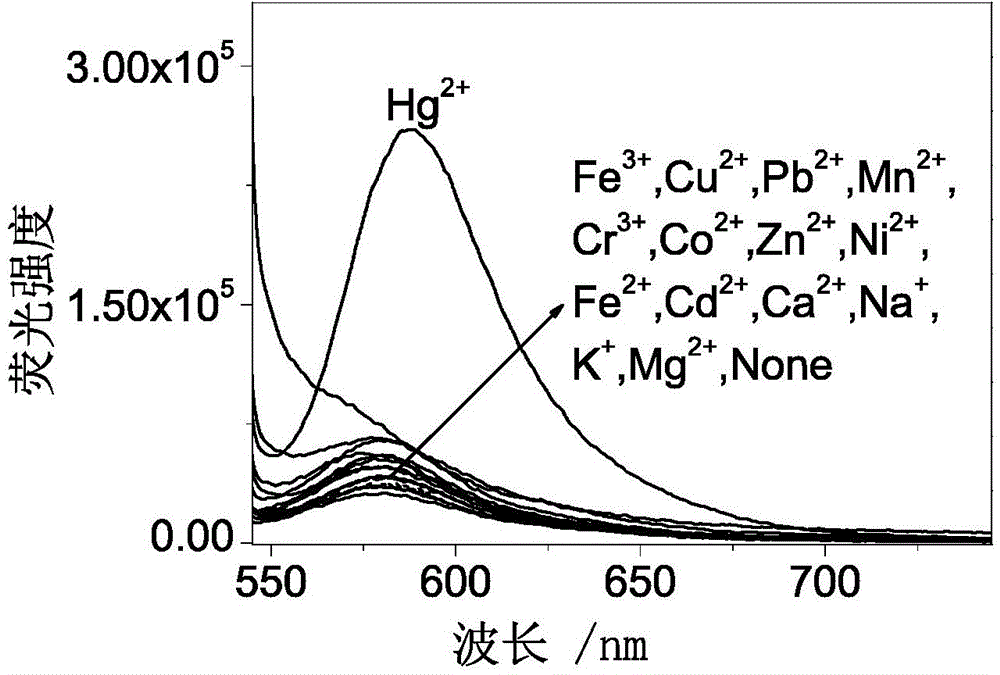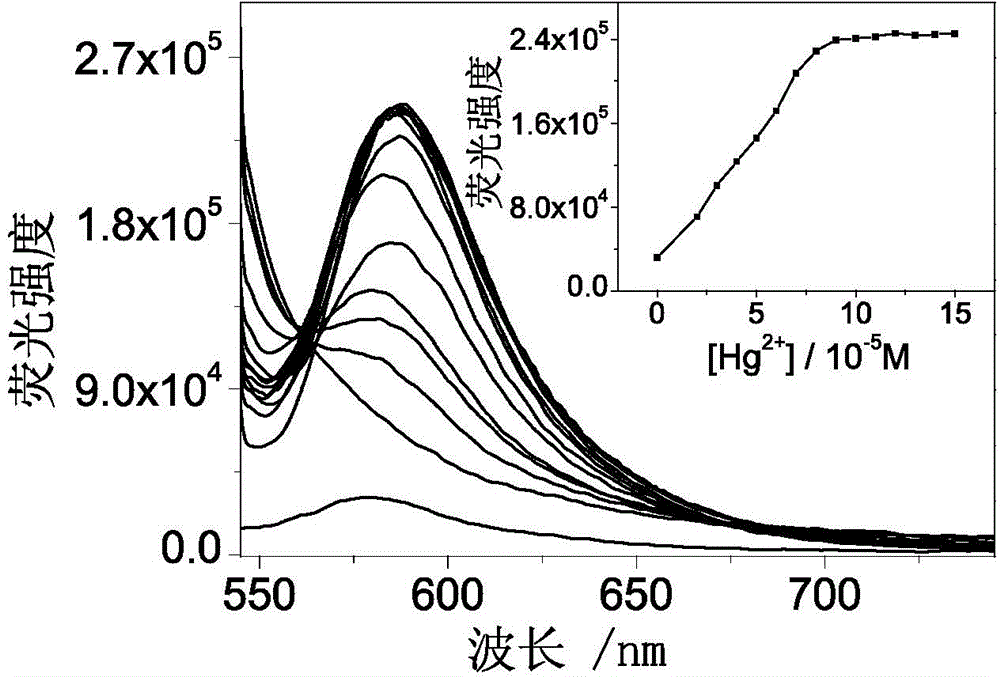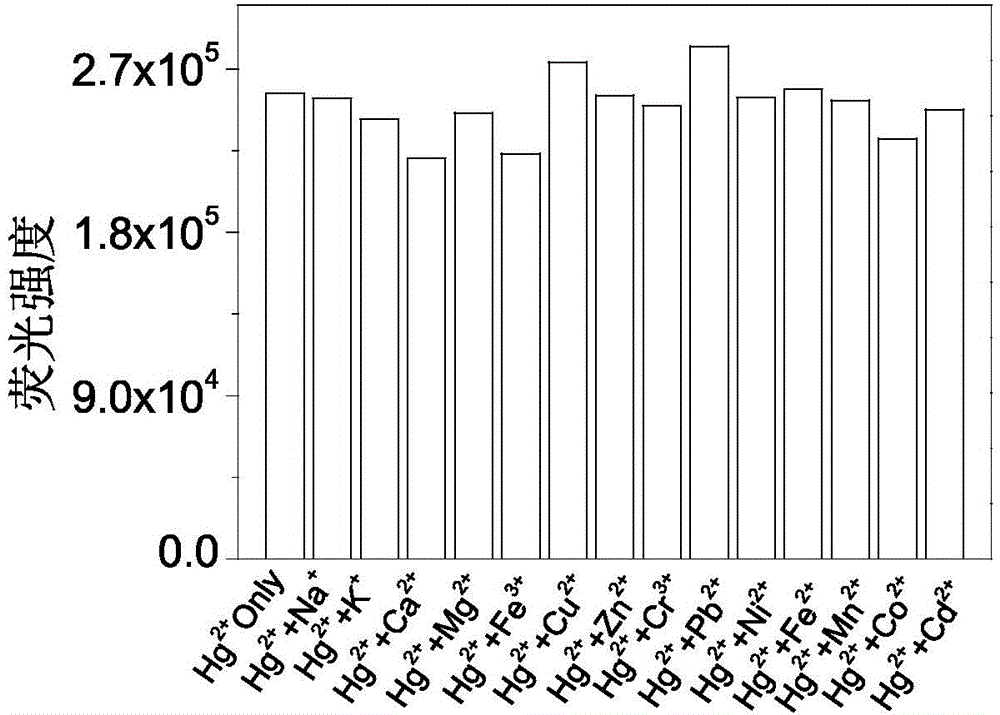Fluorescent probe made of rhodamine B, diethylenetriamine and PITC (phenyl isothiocyanate) as well as preparation method and application thereof
A technology of diethylenetriamine and phenylthiourea, applied in chemical instruments and methods, fluorescence/phosphorescence, luminescent materials, etc., can solve the problems of inability to detect, low sensitivity, poor selectivity, etc., and achieve good practicability , improve the detection sensitivity, improve the effect of selectivity
- Summary
- Abstract
- Description
- Claims
- Application Information
AI Technical Summary
Problems solved by technology
Method used
Image
Examples
Embodiment 1
[0033] Embodiment one: Hg 2+ Preparation of probe RDTU.
[0034] Using ethanol as solvent, dissolve 1 g (2.09 mmol) rhodamine B in ethanol, then add 1.57 mL (14.63 mmol) diethylenetriamine dropwise, heat to 81°C for 3 h, stop the reaction, and cool To room temperature, the solvent was removed by rotary evaporation, then washed twice with deionized water, and filtered to obtain a khaki solid powder, which was the spirocyclic amide intermediate RDTA, with a yield of 94.8%.
[0035] Dissolve 0.2 g (0.36 mmol) of the intermediate RDTA and 85.4 μL (0.72 mmol) of phenyl isothiocyanate in acetonitrile, heat to 50 °C for 6 h, cool to room temperature, remove the solvent by rotary evaporation, separate on a silica gel column, wash The removal agent is a mixture of ethyl acetate and petroleum ether (v / v, 1 / 2), and a white solid powder is obtained, which is rhodamine B-phenylthiourea derivative (Hg 2+ probe) RDTU with a yield of 30.1%.
[0036] IR (KBr) cm -1 : 3413 (NH), 2968, 2926 ...
Embodiment 2
[0038] Embodiment two: Hg 2+ Preparation of probe RDTU.
[0039] Using methanol as a solvent, dissolve 1 g (2.09 mmol) rhodamine B in methanol, then add 1.12 mL (10.45 mmol) diethylenetriamine dropwise, heat to 65 °C for 10 h, stop the reaction, and cool to At room temperature, the solvent was removed by rotary evaporation, then washed twice with deionized water, and filtered to obtain a khaki solid powder, which was the spirocyclic amide intermediate RDTA, with a yield of 45.7%.
[0040] Dissolve 0.2 g (0.36 mmol) of the intermediate RDTA and 170.8 μL (1.44 mmol) of phenyl isothiocyanate in tetrahydrofuran, heat to 50 °C for 6 h, cool to room temperature, remove the solvent by rotary evaporation, separate on a silica gel column, wash The removal agent is a mixture of ethyl acetate and petroleum ether (v / v, 1 / 2), and a white solid powder is obtained, which is rhodamine B-phenylthiourea derivative (Hg 2+ probe) RDTU, yield: 38.1%.
Embodiment 3
[0041] Embodiment three: Hg 2+ Preparation of probe RDTU.
[0042] With isopropanol as solvent, 1 g (2.09 mmol) rhodamine B was dissolved in isopropanol, then 1.79 mL (16.72 mmol) diethylenetriamine was added dropwise, heated to 82 °C for 8 h, Stop the reaction, cool to room temperature, remove the solvent by rotary evaporation, then wash twice with deionized water, and filter to obtain a khaki solid powder, which is the spirocyclic amide intermediate RDTA, with a yield of 82.5%.
[0043] Dissolve 0.2 g (0.36 mmol) of the intermediate RDTA and 170.8 μL (1.44 mmol) of phenyl isothiocyanate in acetonitrile, heat to 50 °C for 4 h, cool to room temperature, remove the solvent by rotary evaporation, separate on a silica gel column, wash The removal agent is a mixture of ethyl acetate and petroleum ether (v / v, 1 / 2), and a white solid powder is obtained, which is rhodamine B-phenylthiourea derivative (Hg 2+ probe) RDTU, yield: 46.6%.
PUM
 Login to View More
Login to View More Abstract
Description
Claims
Application Information
 Login to View More
Login to View More - R&D
- Intellectual Property
- Life Sciences
- Materials
- Tech Scout
- Unparalleled Data Quality
- Higher Quality Content
- 60% Fewer Hallucinations
Browse by: Latest US Patents, China's latest patents, Technical Efficacy Thesaurus, Application Domain, Technology Topic, Popular Technical Reports.
© 2025 PatSnap. All rights reserved.Legal|Privacy policy|Modern Slavery Act Transparency Statement|Sitemap|About US| Contact US: help@patsnap.com



